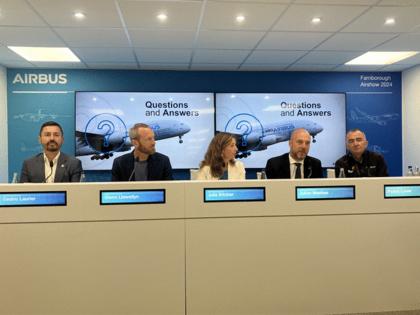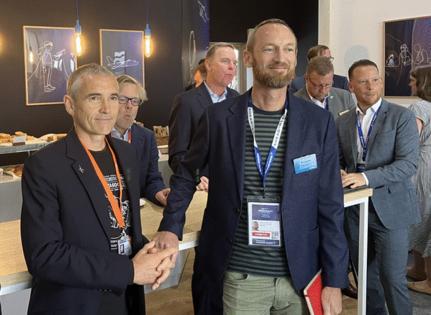Green aviation solutions have yet to take off as climate restrictions loom
Published in Business News
FARNBOROUGH, England — The aviation industry has preached for years that low-carbon sustainable aviation fuel, or SAF, will be key to making the airline business carbon neutral. Yet production of SAF is so abysmally low that last year it represented about 0.1% of all the jet fuel used worldwide.
Environmental groups are losing patience.
“Supply of SAF currently is, we can call it zero,” said Dan Rutherford, aviation director at the Washington, D.C.-based International Council on Clean Transportation.
But at the Farnborough Air Show, top executives at both Airbus and Boeing didn’t blink. They preached the gospel of SAF as hopefully as ever.
They insisted that production of this substitute jet fuel should soon take off — if only governments can provide potential SAF producers some revenue guarantees.
“I’m not discouraged about where we are,” Boeing Chief Sustainability Officer Brian Moran said at one sustainability session. With the announced plans to build SAF production facilities across the world, “we’re trending in the right direction.”
Likewise, Airbus Chief Sustainability Officer Julie Kitcher at another gathering said global SAF production doubled in 2023 and is expected to triple next year, though she did add that “frankly, it’s all off an extremely low base.”
At that event, Airbus presented a British startup partner called Zero Petroleum that is developing so-called e-fuel.
That’s a type of synthetic SAF made from water and air with almost no or zero carbon emissions.
It’s the holy grail of green aviation, but one with tremendous challenges.
ICCT’s Rutherford published a paper just before Farnborough concluding that not enough SAF can be produced for aviation to reach its target of net-zero carbon emissions by 2050.
In an interview, he said Airbus and Boeing need to launch new “aircraft that fundamentally don’t need fossil fuels.”
Which brings us to the other great hope for carbon-free flight: hydrogen-powered airplanes.
On this technical goal, a divergence became clearer at Farnborough. Airbus reiterated its target of building a single-aisle-size hydrogen plane by 2035 and gave updates on progress.
But in a Boeing briefing, while top executive engineers said they are studying the potential, they also frankly conveyed their judgment that hydrogen is unlikely to work for large airplanes.
Mike Sinnett, Boeing vice president responsible for future airplane development, said a hydrogen plane would have to be much bigger to hold enough of the high-volume hydrogen fuel. Genuine progress requires cleaner fuels in better airplanes, Sinnett said, “not cleaner fuels and bigger, slower, more draggy airplanes.”
For hydrogen flight, he said “we’re not so optimistic about the future.”
Unfortunately, the aviation’s endlessly repeated goal of achieving carbon-neutral flight by 2050 seems distant.
‘Green aviation’
As in previous years at the major aviation events, the industry’s “green aviation” push to decarbonize flying was an insistent theme at Farnborough. The industry fears that political pressure, especially in Europe, may curtail flying if it doesn’t reduce carbon emissions.
While aviation represents less than 4% of total human-induced carbon emissions today, that share will grow as air travel expands worldwide.
Boeing projects the global fleet of commercial airplanes is set to double in the next two decades.
Francesco Catte, aviation policy manager at Transport & Environment, a European advocacy organization for clean transportation and energy, said environmentalists agree that SAF has to be a big part of the solution.
SAF is made from a variety of feedstocks, some greener than others. SAF from cooking oil or municipal waste is considered good, but is available in limited quantities.
SAF “is one of the few solutions that the aviation sector has to decarbonize,” said Catte. “Investment needs to happen now.”
Many planned production plants are on indefinite hold. Dutch company SkyNRG last year announced it would build an $800 million SAF plant in Washington state. There’s no sign of it yet.
In the foreword to SkyNRG’s SAF market outlook, published in June, CEO Philippe Lacamp wrote that in the United States, “significant investments are ready to be deployed, contingent upon guaranteed long-term revenue certainty from supporting policies.”
“This year will be key,” Lacamp wrote. “Most announced facilities still face the challenges of raising capital, construction, and commissioning.”
Likewise, the major oil and energy companies, which could repurpose refineries to produce SAF, have not and seem to be waiting for some form of government guarantee of long-term income.
SAF “is the most immediate way toward achieving a lower carbon footprint for the industry,” said John Plueger, CEO of prominent airplane leasing company Air Lease Corp., in an interview before the air show. “But it is taking an awful long time to get there.”
Transport & Environment considers synthetic e-fuel the cleanest possible fuel that should be the focus for the future.
To produce e-fuel, electricity from a renewable source is used to split hydrogen out of the water. That’s combined with CO2 — either extracted from the air or from biomass — to produce the hydrocarbon fuel, which can substitute for gasoline, diesel or jet fuel.
T&E has identified at last count 56 startup e-fuel projects in Europe. However, none have reached a final investment decision.
All are looking for funding. The T&E briefing paper cautions that they “should be considered as hypothetical until they actually materialize.”
In the U.S., California-based clean energy startup Twelve is gearing up to produce e-fuel in Washington state — but not yet.
A year after breaking ground, Twelve is constructing its first small commercial facility in Moses Lake. CEO Nicholas Flanders said he expects the plant to come online next year.
At Farnborough, Paddy Lowe, a dynamic Irishman with a previous career in Formula One racing who founded Zero Petroleum, described prospects for his e-fuel startup, now partnered with Airbus, in optimistic terms.
He has 52 employees and has raised about $30 million, roughly half of it government money, he said.
His team is designing modules for an initial small commercial e-fuel plant, which he estimates will need an investment of $110 million. He’s hopeful about securing that.
“This is a capital challenge. The technology is here,” Lowe said. “We can produce fuel at scale within perhaps two years.”
While e-fuel will initially be expensive, he projects reaching cost parity with fossil fuels “within as little as 10 years.”
One of the challenges Zero will face, along with all e-fuel producers and the separate projects working on hydrogen-powered airplanes, is that in addition to a lack of SAF, there is an acute shortage of so-called “green” or renewable hydrogen.
Most hydrogen is produced today in a process that releases carbon.
“Plug in a hydrogen airplane today, where 98% of the hydrogen isn’t green, you’re making the problem worse, not better on a total life cycle basis,” said Boeing’s Moran.
He pointed out that other industries, from cement to steel, are eager to get the scarce green hydrogen.
Moran added that the best use of green hydrogen within aviation could be to produce e-fuel. Still, there are projects instead to use it directly to power airplanes.
That can be done either by using a fuel cell to produce electricity that drives the engine, or by combustion, burning the hydrogen like jet fuel.
Airbus is researching both options, said Glenn Llewellyn, Airbus vice president for zero-emission aircraft. He said Airbus is also working with airports to explore how a hydrogen fuel distribution infrastructure could be set up.
He anticipates “decarbonized hydrogen being available in quite significant quantities at airports in the future.”
Llewellyn said Airbus ground tests of a hydrogen engine are underway in Munich, Germany, and this year a flight test engine will be assembled for testing on an A380.
Llewellyn, another dynamic Irishman, is an evangelist for hydrogen as a way to save aviation and the planet.
Boeing, in contrast, is skeptical of the technology.
Sinnett said Boeing is conducting “a number of studies” on hydrogen, in part because “there could be legislation or policy that drives us in that direction.”
“We don’t have anything in the pipeline that’s committed,” he said.
While the contrast with Airbus’s messaging is striking, it’s worth noting that the proposed new Airbus hydrogen plane won’t get the green light for serious funding for years, if ever.
The only near-term possibility for hydrogen flight is in much smaller planes. California-based ZeroAvia is retrofitting Cessnas with hydrogen fuel cell motors. It has a propulsion research facility in Everett.
This sector had a big setback just last month with the financial collapse of Universal Hydrogen, a startup that last year flew a partially hydrogen-powered test flight at Moses Lake.
In an interview at Farnborough, Val Miftakhov, CEO of ZeroAvia, said Universal started with too big an aircraft, the turboprop de Havilland Canada Dash 8-300.
He said he plans to start small and move to retrofit larger aircraft only after the first planes are operating and generating money.
Miftakhov said ZeroAvia plans to put its first commercial-scale hydrogen fuel production at Paine Field in Everett, close to a small airplane company that will be a launch customer to operate his first hydrogen-powered airplane sometime “in the next two years.”
Whether it’s SAF or hydrogen, the aviation world is a very long way from getting to net zero.
“The clock is ticking,” said Airbus’ Kitcher.
Julien Manhes, Airbus head of SAF and carbon dioxide removal, told a U.K. industry gathering at Farnborough: “I wish to talk to you again in the next Farnborough to drink a couple of glasses of Champagne and celebrate 1% or 2% or 3% of total fuel burn being SAF.”
Don’t break out the Champagne just yet.
©2024 The Seattle Times. Visit seattletimes.com. Distributed by Tribune Content Agency, LLC.















Comments